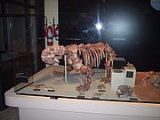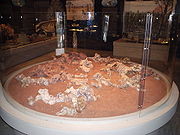
Dinodontosaurus
Encyclopedia

Genus
In biology, a genus is a low-level taxonomic rank used in the biological classification of living and fossil organisms, which is an example of definition by genus and differentia...
of dicynodont
Dicynodont
Dicynodontia is a taxon of anomodont therapsids or mammal-like reptiles. Dicynodonts were small to large herbivorous animals with two tusks, hence their name, which means 'two dog tooth'...
therapsid. It was one of the largest herbivores of the Triassic
Triassic
The Triassic is a geologic period and system that extends from about 250 to 200 Mya . As the first period of the Mesozoic Era, the Triassic follows the Permian and is followed by the Jurassic. Both the start and end of the Triassic are marked by major extinction events...
(about 8 feet (2.4 m) long and weighing a few hundred pounds) and had a beak corneum. It lived in the Middle Triassic
Middle Triassic
In the geologic timescale, the Middle Triassic is the second of three epochs of the Triassic period or the middle of three series in which the Triassic system is divided. It spans the time between 245 ± 1.5 Ma and 228 ± 2 Ma...
but disappeared in the Upper Triassic.
Dinodontosaurus turpior is the most common species of dicynodont
Dicynodont
Dicynodontia is a taxon of anomodont therapsids or mammal-like reptiles. Dicynodonts were small to large herbivorous animals with two tusks, hence their name, which means 'two dog tooth'...
that existed in the Middle Triassic
Middle Triassic
In the geologic timescale, the Middle Triassic is the second of three epochs of the Triassic period or the middle of three series in which the Triassic system is divided. It spans the time between 245 ± 1.5 Ma and 228 ± 2 Ma...
, and more common in the fossil layers that age in Rio Grande do Sul
Rio Grande do Sul
Rio Grande do Sul is the southernmost state in Brazil, and the state with the fifth highest Human Development Index in the country. In this state is located the southernmost city in the country, Chuí, on the border with Uruguay. In the region of Bento Gonçalves and Caxias do Sul, the largest wine...
, in geopark
Geopark
A Geopark is defined by the United Nations Educational, Scientific and Cultural Organization in its UNESCO Geoparks International Network of Geoparks programme as follows:...
of paleorrota
Paleorrota
Paleorrota , is a geopark located in the center of the Brazilian state of Rio Grande do Sul. The rocks and fossils found along the route date back to the times when there was only one supercontinent Pangaea....
. They are found mainly in the Paleontological Site Chiniquá
Paleontological Site Chiniquá
Palaeontological Site Chiniquá is located in the Brazilian city of São Pedro do Sul, Rio Grande do Sul. That the margins of the highway BR-287, with an area of about 250 hectar. It is located at 70 kilometers from the city of Santa Maria. The site belongs to geopark of paleorrota...
in São Pedro do Sul
São Pedro do Sul, Rio Grande do Sul
- Paleontology :This city belongs to the geopark of Paleorrota.Museum of the city that have fossils:#Museum Paleontologic and Archaeological Walter Ilha.-Day of Paleorrota:...
and Candelária
Candelária, Rio Grande do Sul
- Paleontology :This city belongs to the geopark of Paleorrota.Museum of the city that have fossils:#Museum Aristides Carlos Rodrigues.-Day of Paleorrota:...
, where a group of ten pups were found together, demonstrating that these animals had strategies for coexistence in a group and caring for their offspring.


